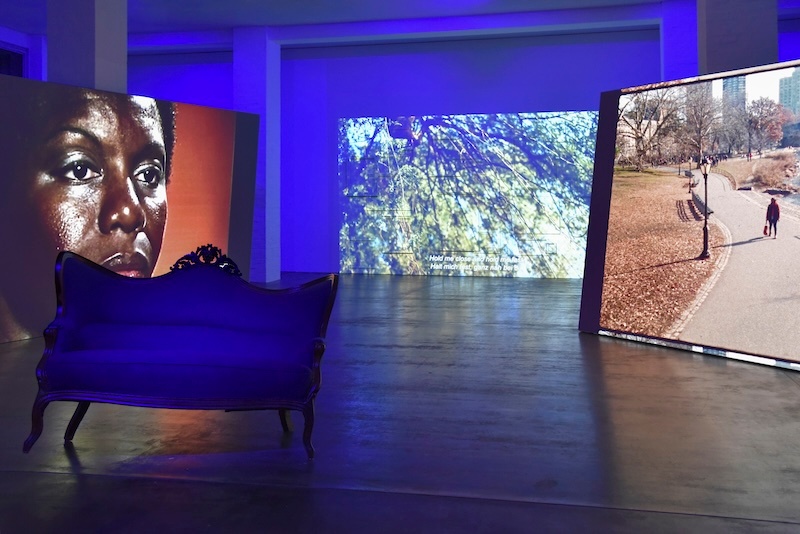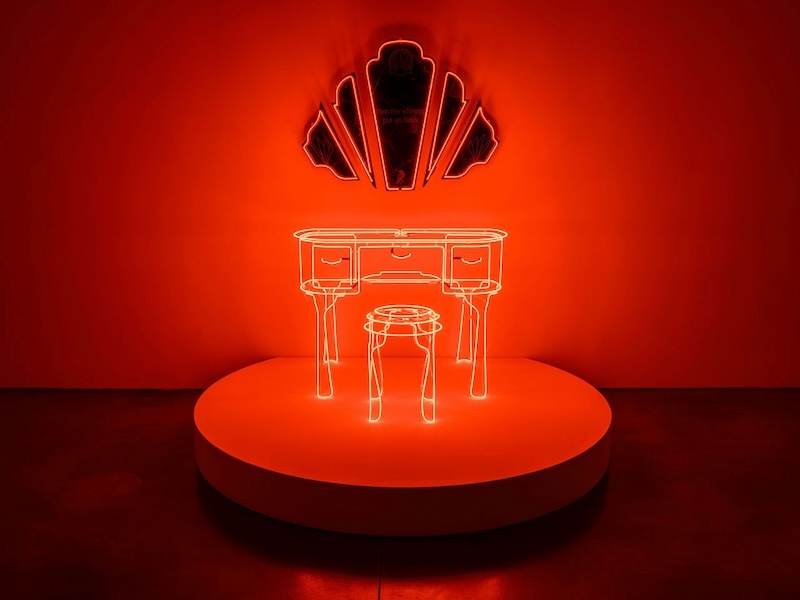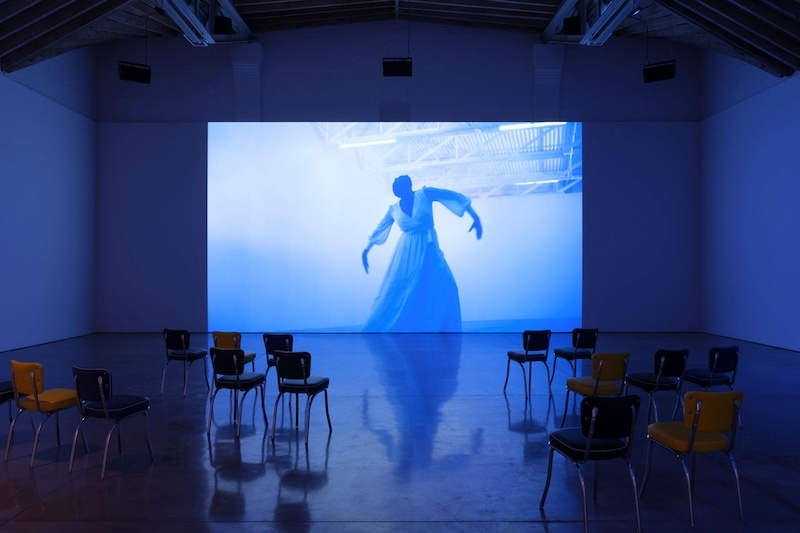How would you describe your creative practice?
I’m going through such a crazy transformation in life right now. I definitely am an artist, but I saw something recently online that said, “Art exists, but the artist is a myth.” I found that interesting because in my mind, everybody is an artist. Everybody strives to be an artist in our online-driven space, where everyone is making something, positioning themselves to be seen, or hoping to sell something—whether they made it or whether they stole it. Everybody is attempting to position themselves as a creator. With the idea that art exists, but the artist is a myth—that’s a different framework. It is through this understanding that we all have the creative capacity to make something and to envision something and to render that into reality. But what we’re seeing now is a marketplace where everyone is intent on selling something and not necessarily centering what they can contribute to the betterment of the collective.
I’m trying to see myself through the lens of the former, the myth of the artist, the artist as contributor, the artist as a member of the collective. What am I offering up that will be helpful in some way that will bring about beauty, that will bring about understanding, that will bring about the transformation that we are so desperately in need of?
I think a lot of this does come from the fact that I descend from these people who were all about service, whether they were the preachers or the evangelists that I come from, or whether they were working with the homeless or they were answering the phones on the prayer hotline where folks will call in and ask for prayer. It’s really about what we can do, what we can give that will alleviate some sort of suffering or bring about some understanding or change the way we view things.
I’m not out to make myself out to be some sort of martyr. I definitely get paid for what I do. I operate within the context of capitalism, but I definitely see myself as somebody who is a conduit or a vessel, and the contributions that I’m bringing forth are hopefully very necessary and useful. Whether it is a film or an object or whether it’s a talk, or something that has been said or shared, or a written piece. I’m hoping that it can be of some sort of edification for the collective and not just for myself. Now whether the collective can receive it or not is another question. Maybe it’s a collective that has yet to come, a future collective, a future group of people who have yet to be born.
Ja’Tovia Gary: THE GIVERNY SUITE (2019), ZOLLAMT MMK / MUSEUM MMK FÜR MODERNE KUNST, Frankfurt, as part of IDEOLOGIES: Triennial RAY Festival, June 3 - August 8, 2021. Photo: Leonore Schubert.
I love thinking about art making as an offering or in service. You touch on a lot of things I wanted to cover with you, particularly on these themes of perception and gaze and performance, which are central to your work. What advice would you give to other artists or creatives who are trying to develop their unique point of view or find their artistic voice?
I think when you’re very early starting out, oftentimes the impulse is to latch onto something that you’ve seen and maybe emulate aspects of it, if not the entirety of it. And that’s normal. But understand that that is the beginning of the thing. One cannot get comfortable emulating or attempting to reenact something that you have already seen before because it’s already been done. I would encourage emerging artists to have the courage to do the thing that naturally occurs or the impulse that naturally springs forth inside of them unabashedly, without worry, without fear. In fact, especially if it scares them. If im fearful of the project, then I know that I am on to something interesting.
And of course, it’s very hard, right? It’s easier to say this than to do it, but move ahead into unmarked territory as strongly as you can, as often as you can, even when that requires a certain amount of failure, even when that may require a bit of ostracization. Attempting to break new ground is what the artist is supposed to do. The artist is here to show us things that we are unfamiliar with, whether they’re about ourselves or whether it’s about the collective. We are here to expose in many ways what can be done, what can emerge, to excavate the future from the ashes of the past. Some of the most incredible things that I’ve done have come from mistakes or started initially from a place of fear. Forge ahead anyway!
Also within the theme of perception and being seen—I want to talk about audience. With your art making, do you have an audience in mind? What advice might you have for artists who are searching for their audience?
Historically, I’m always thinking about Black people when I’m making work. When I was coming up in schools, and even when I was fundraising for things, everyone really stressed the universal. And for me, I felt like there was subtext underneath that. It meant “How are white people going to access this?” And for me, as a Black person who’s been alive for almost 40 years, white people are going to come and look at it regardless, especially if it’s for Black people. My idea of universal is to be very specific. This is a notion that comes from Toni Morrison…the more detailed and specific you are about your audience and about your experience when you are creating your work, the more universal it becomes.
If I were constantly thinking about the larger audience, the global audience, then everything would be watered down. I would be worried about whether or not they can understand it. In order to streamline my message, in order to get very clear about what I’m saying, in order to know what to leave out, in order to know what to specify, what to define or not define, I’m thinking of the Black audience member. Sometimes that gets very specific. I might be thinking of a Black woman. I might be thinking of the Black South. But there is a nuanced reality that I’m trying to get at. Now, of course, that doesn’t mean that white people can’t watch the films or experience the work. No, I am just one lone Black woman in America. I can’t stop anyone from doing anything. But what I can do is be very, very clear about what I’m trying to say. And that’s also something that I recommend for young artists coming up. What are you saying and who are you talking to? Those are two questions that I’m constantly asking myself when I’m making my work.
Ja’Tovia Gary, Citational Ethics (Zora Neale Hurston, 1943), 2023, copyright Ja’Tovia Gary, courtesy Paula Cooper Gallery, New York Photo: Steven Probert
To go even deeper on audience, something I’ve been wrestling with is representation and representational politics, which have been packaged and offered to marginalized communities as this magic remedy for undoing oppression. What’s your evaluation there? How do we hold that tension between visibility, with its potential to be a resource and a lifeline, but also making us vulnerable to theft, appropriation, or even violence?
Or continued death, right? Visibility doesn’t equal power. I think representational politics is a neoliberal proposition that maintains, “We’ll allow a few of you to reach a higher perch. Maybe you’ll have a really good job. Maybe we’ll allow a Black president, maybe we’ll put a bunch of Black folks as CEO’s or the head of this corporation or this company. Maybe we’ll give a few of you grants, and we will market that as some sort of liberatory gain for the whole.” When in actuality, what we do is create a kind of overseer class or a kind of managerial class, which has always been in play with this formation in some ways.
We have an ownership class, elite class, and we have a bonded class whose labor we can accumulate money and capital off of. What we’ve done is we’ve traded trinkets that don’t even belong to us. They belong to that managerial class. We’ve traded the opportunity to clap for a Black person succeeding for liberation. “Peaceful coexistence.” That’s actually quite scary, and it’s really quite interesting because a lot of people see this continuum of time as if we are progressing, when in actuality if we remove that very Western idea of linear time, we’ll see that time kind of spirals. It’s all over the place. We’re constantly moving forward and constantly moving backwards all the time. Yes, there are some things that we have accomplished as a collective, but as you see now very clearly, there’s still a very , brutal regime and formation at play that is intent upon grinding us down in order to maintain domination of the resources here on earth.
We talked about your resistance to the linear conception of time. I want to talk about how that might translate process wise. How do you start a project and how do you know when a project is done?
When I start a project, it’s a kind of investigation and curiosity at the beginning. I’m basically culling materials. I’m gathering. A lot of the work takes on a collage aesthetic. So I am thinking through an idea and then gathering all of the supporting documents. In some ways it’s essayistic. I’m attempting to put forth an idea or a thesis. There are assertions that are being made, and what can I use visually, whether it is 16 millimeter film from the past or things that I shoot myself, whether it’s interview that I go out and get, whether it’s me painting on film and creating some sort of abstraction that alludes to or gestures towards the assertion. It’s playtime at the beginning. It’s almost like a very active brainstorming that requires me to go out and find materials as well as make notes, as well as look at footage as well as read. It’s investigative curiosity at the beginning, this phase of questioning and garnering. And at the end it’s instinctual. It’s a sweet spot. There have been times where I’ve gone out and presented something thinking that it’s done and then brought it back. I’ve gotten audience reactions, brought it back, turned it up a little bit, and then it was done. Sometimes my finishing process requires me to see it with a large group of people.
Ja’Tovia Gary, You Smell Like Outside… at Paula Cooper Gallery, 2023, copyright Ja’Tovia Gary. Courtesy: Paula Cooper Gallery, New York. Photo: Steven Probert.
Can you talk a little bit more about process? Given that your work with your material is so intimate, how do you avoid burn-out with labor intensive art-making?
Well, I don’t handle the film material or do direct animation all the time. It’s something that I return to when I need that space or when a project demands it. I know that I’m usually going to need the animated abstractions , and oftentimes it comes at the very beginning of a film. And it’s fun. It is not an obligation, it is moreso play. So, I don’t view the animating as an activity that produces burnout, though it does take its toll on the body. The burnout to me comes when you’re editing. There are moments of tedium during the edit that can feel like drudgery. Then there are moments of deep exploration and discovery so it all works out in the end. Anything can be a burnout, of course, if you’re doing it repetitively and you’re not taking a break and you’re not resting. But for me, the painting and the interaction with the materials is a freeing space. There’s no burnout usually there because it is like play. It’s literally me painting and drawing and-
Improvisation.
Yeah, exactly. Improvisation. The child self emerges, the child artist emerges, and things get very elemental and foundational and emotional. This part of the process is integral to everything because I feel like without it, the work would be so heady. Even if people can’t understand all of my work, people always have questions. Even if they can’t understand every single cut or every single totem or image or figure that’s presented, there’s always an emotional response that emerges after they see it. It’s in their body. And I attribute that to the works with the material. I attribute that to the painting and the etching, that play, that improvisation. It has to be that. That’s where the life force is.
Has there been anything that work has taught you about yourself?
There’s a lot… I can’t talk too much about it. But, I’m working on something that has a trajectory of 10 years. I see myself 10 years ago, in fact I see myself even earlier, because there’s a bunch of archival footage present on the timeline. I see a vast change in who I am as a human being and an artist. Not just how I look, because of course you can chart time via the changes in someone’s appearance, but hearing and seeing testimonials from myself on camera, direct address. What I witness is such a vast difference in who I am now versus then. And it’s really wild to see. So, I can’t necessarily say what it’s taught me just yet, except that people change. They self actualize and they hopefully become healed or at least move towards a healed space. You can become a different person. That’s actually my favorite thing about Malcolm X is that he transformed himself multiple times over. He became a different person and always for the better. He kept leveling up. And to see this on the timeline is quite remarkable. I’m excited.
Ja’Tovia Gary Recommends:
Qigong: I’m practicing Qigong, and it’s amazing.
My puppy: I also just got a new puppy. She’s a standard poodle. Her name is Sheba and she’s Jet Black.
The books of Jesmyn Ward: She’s won the National Book Award twice. She’s a southern black woman novelist from Mississippi, and I’m late to the party, but boy am I glad to be there.
Joy James: A lot of her talks on YouTube, I’m devouring, and I’m going to get into her book In Pursuit of Revolutionary Love.
Beets: I hated beets in the past, but I just started juicing beets, and the trick is to put pineapple with the beets.
This content originally appeared on The Creative Independent and was authored by Pola Pucheta.
Pola Pucheta | Radio Free (2024-05-14T07:00:00+00:00) Visual artist and filmmaker Ja’Tovia Gary on creating without fear. Retrieved from https://www.radiofree.org/2024/05/14/visual-artist-and-filmmaker-jatovia-gary-on-creating-without-fear/
Please log in to upload a file.
There are no updates yet.
Click the Upload button above to add an update.


